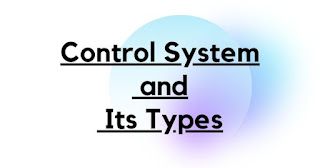Control system is very important in field of engineering as it finds wide application not only in engineering but also in non-engineering discipline. It makes control system very special and interesting. Study of automatic control system involves a lot of mathematical treatment.
The first automatic control system is a fly ball governor to control speed of a steam engine. It was invented by James Watt in 1770. This governor used to keep the speed of the engine constant by regulating supply of steam to the engine.
Control system also finds application in non-engineering fields. A simple example is an automatic anaesthetic control.
The degree of anaesthesia of a patient undergoing operation can be measured from encephalograms. More complex and complete feedback models are now available in both engineering and non-engineering field. This make study of control system more popular and challenging.
BASIC ELEMENTS OF CONTROL SYSTEM
A control system consists of several elements where each element performs a particular task. These elements are connected in a proper sequence and facilities signals to flow through them. Different control action are performed by these elements to obtain a desired output.
Basic elements of control system depends on the type of control system. Main types are open loop control system and closed loop control system.
Types of Control System:
OPEN LOOP CONTROL SYSTEM
Open loop control system has no feedback element. Hence, control action is independent of output.
The basic elements of an open loop control system are the controller and controlled process. The controller may be amplifier, filter circuits etc. Input (r) is applied to the controller where some control action are performed and a signal is obtained from the controller. The controller is connected to a controlled process which is a regulating system. Signal obtained from controller is fed to the controlled process which further process the signal and gives desired output (c). The direction of flow of signal is unidirectional. Input signal flows in forward direction from the controller to the controlled process and finally output signal is obtained.
Examples of Open Loop Control System
- A washing machine is an open loop control system. Here, time of washing is predefined and the machine stop after set time.
- Field control and armature control of DC machine are examples of open loop system.
- Immersion rod is an open loop system. When power is ON, the rod is heated but it can not sense how much heat is required.
- Traffic light control system where lights are ON/OFF after a predefined set time.
Advantages of Open Loop Control system
- Construction of open loop system is simple in nature.
- Cost of the system is less
- Maintenance is easy and cheap.
- Open loop system are generally stable.
Disadvantages of Open Loop Control System
- Open loop system is slow and less reliable.
- Operation of an open loop system is affected due to non-linear element.
- This system has less accuracy.
CLOSED LOOP CONTROL SYSTEM
A closed loop control system is one in which the output has an effect on controller and controlled process through a feedback element. Thus, this system is called feedback control system. The closed loop control system are composed of three basic elements:
(i) feedback element
(ii) controller
(iii) controlled process
1. Feedback Element : It is a device which converts output signal (c) to another suitable variable feedback signal. This feedback signal is compared with the input signal in the error detector of controller.
2. Controller : The controller consists of two elements:
(a) error detector
(b) control element
The error detector compares the feedback signal and input signal. Thus an error signals (e) is obtained from the error detector. Error signals (e) is the difference of input signal (r) and feedback signal. Error signal is fed to the control elements to produce a control signal. The control elements consists of amplifier and a power stage. The error signal is usually at low lower power stage. This needs a power stage in control elements so that the control signal can drive the controlled process.
3. Controlled Process : The plant or process that produces the desired output is called controlled process. Control signal obtained from the controller is fed to the controlled process to produce desired output. Thus a closed loop control system maintains the output at a desired level.
Example
A room AC which regulates both temperature and humidity of a particular level.
Advantages of Closed Loop Control System
- Performance of closed loop control system is less affected by non-linear elements.
- It is more reliable.
- It is faster.
- Output can be maintained at a desired level.
Disadvantages of Closed Loop Control System
- Closed loop system is complex in construction.
- Overall cost of this system is more.
- Maintenance is difficult.
- Closed loop system may be unstable under certain conditions.


Comments
Post a Comment